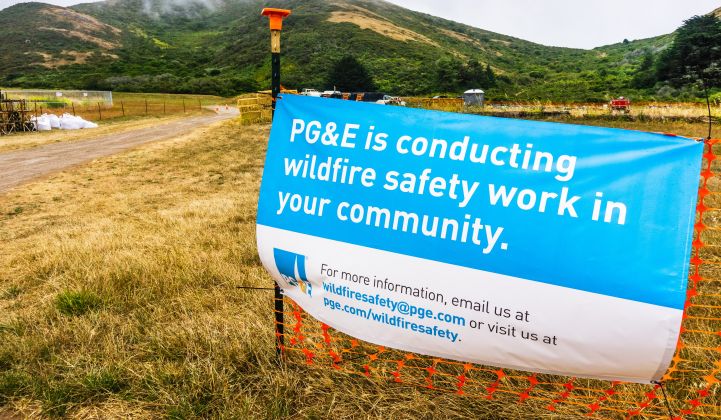Pacific Gas & Electric submitted a bankruptcy reorganization plan Monday that would pledge up to $18 billion to wildfire victims and allow the California utility to exit bankruptcy by mid-2020, a key deadline for it to take part in a multi-billion dollar state wildfire fund.
The plan also pledges to honor PG&E's legacy renewable energy contracts, easing concerns from the solar and wind generators holding those contracts.
The plan marks the beginning of negotiations between creditors, shareholders and fire victims. Even before its release, it had already faced a setback. This past Friday, state lawmakers shelved a bill that would have offered PG&E access to as much as $20 billion in bonds to cover liabilities for the 2017 and 2018 wildfires that drove it into bankruptcy.
PG&E’s plan proposes $16.9 billion in payments to wildfire victims, but would cap payouts at no more than $18 billion. That’s less than the upward range of damages being sought from private victims and public entities for the 2017 and 2018 wildfires caused by PG&E equipment — a range that includes last year’s Camp Fire, the state’s deadliest to date, with damages estimated in the $15 billion range.
Still, it’s more than the $14 billion proposed in a $31 billion PG&E restructuring plan Bloomberg reported on in June. It’s also in line with the $16 billion to $18 billion for claims in a $30 billion alternative plan, proposed by major bondholders, including Elliott Management Corp. and Pacific Investment Management Co., that would give them a majority stake in the utility.
This plan has become the focus of opposition from a group of companies that control about 49 percent of PG&E shares, dubbed Shareholders for Wildfire Victims.
PG&E said its reorganization plan honors its roughly $42 billion in power purchase agreements (PPAs), much of that tied up in legacy solar, wind and other renewable energy projects. A bankruptcy court ruling in June could have allowed PG&E to renegotiate or cancel those PPAs, a threat that led to credit downgrades for some of the project companies behind the PPAs, including units of Consolidated Edison, Berkshire Hathaway and NextEra Energy.
PG&E pledged in August to honor its PPAs, under pressure from state lawmakers and regulators worried that breaking them could undermine the state's renewable energy goals. Still, the company has negotiated some "voluntary modifications" of contracts that have seen developers take a slight cut.
Canadian Solar subsidiary Recurrent Energy took a voluntary pay cut of 10 percent on three solar projects, Reuters reported. And Hummingbird Energy Storage and mNOC took a similar cut on their energy storage contracts that are part of the Moss Landing portfolio.
PG&E is under pressure to exit bankruptcy by the end of June 2020, or be excluded from participating in the $21 billion wildfire fund created by the legislature earlier this year, largely to protect investor-owned utilities Southern California Edison and San Diego Gas & Electric. Those utilities have been facing steep credit downgrades over the past 18 months, and could have been forced into bankruptcy if they were forced to face large-scale wildfire claims under the state’s strict “inverse condemnation” legal doctrine, which holds utilities responsible for damages, whether or not they’re found negligent or at fault for fires caused by their equipment.
Setbacks, challenges to PG&E’s preferred bankruptcy plan
PG&E has continued to face setbacks in the days leading up to Monday’s filing of its reorganization plan. On Friday, California Assemblymember Chad Mayes announced he was shelving until next year a bill that would have allowed PG&E to raise up to $20 billion in bonds to help cover wildfire claims.
The bill, AB 235, was framed as a faster way to pay back fire victims through bonds that would eventually be paid back by company shareholders, according to PG&E and the shareholders group that’s formed in opposition to the bondholders group. But opponents labeled it a PG&E bailout, and spent heavily in advertising to counter the reported heavy lobbying effort from PG&E in support of the bill.
Given the political challenges, Mayes wrote in a Friday tweet that the bill would not be heard this year, given the lack of time for proper debate in the remaining legislative session. He pledged to bring it back up in 2020, noting that “[w]e need to ensure that victims get paid and ratepayers are protected.”
PG&E said in Monday’s plan that it was confident it could raise as much as $40 billion in debt and equity financing to cover the costs of repaying wildfire damages, albeit at a likely higher costs to shareholders.
Friday also brought another wrinkle to PG&E’s path toward reorganization in the form of a $2.5 billion offer from San Francisco to buy PG&E’s grid infrastructure in the city. This offer, which PG&E politely rebuffed in a Friday statement, could be seen as a hostile takeover attempt, given San Francisco’s longstanding disputes with the utility over distribution grid costs and delays, and its efforts to move customers to its community choice aggregator (CCA), CleanPowerSF.




